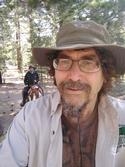Jim Downer is an Advisor who has worked extensively on tree - avocado especially - pathology. His title econpases Pathology of landscape ornamentals , Phytophthora Root Rot, Mulches, Potting soils, Palm horticulture, "climate ready" trees, arboriculture, Master Gardener Advisor.
The word sabbatical comes from the word Sabbath which most of us take to be a day of rest. So naturally most people not affiliated with Universities would assume that sabbaticals are a kind of paid vacation. After a certain number of years professors can leave for a year-long vacation somewhere. The reality of sabbaticals is quite different. As UC academics farm advisors have a sabbatical privilege, although many of my colleagues never take the opportunity. A well-known pomologist in Northern California has never taken one in her entire career. Her choice is not uncommon, because it takes a lot of change to make Change happen. You have to uproot yourself and create a life elsewhere and that takes much planning. A sabbatical is a kind of rest, because we are not doing our normal job functions, but also a time of renewal, study, or exploration that should have outputs of interest to those with whom we work (our clientele).
It is an academic privilege to take sabbaticals, but UC has requirements before we can go. Before we can leave we have to accrue credit toward the sabbatical. It takes about nine years of full time work before we are able to go away for a year. Shorter versions are also possible. While gone, we can't use any of our office or County based resources. In order to go, we need to write a plan that details what will be done, how we fund our activities, what will be learned, and how it will help our clientele. When we return, a detailed report must be filed that describes what was accomplished. Sabbaticals often involve foreign travel, but that is dependent on the nature of the sabbatical. They may be focused on research or on professional development (going back to school). In my last sabbatical over 25 years ago, I did the coursework for my Ph.D. in plant pathology.
On this sabbatical, my emphasis was writing. I have so many projects that were not written up either for journal articles or popular clientele-based publications. I had never written a UC publication before, so that was also a goal ( https://anrcatalog.ucanr.edu/) I was also interested in looking at the origin of some of the “Climate Ready Trees” that grow in the desert Southwest, and finally I did some travel to Thailand and Texas to look at shade trees in very different places.
I took up residence in the small town of Portal, AZ last October (2018). Located there is the South Western Research Station (SWRS). SWRS is a nexus for biologists studying bio diversity in the Chiricahua Mountains of Arizona. I held two meetings - one at the beginning of my sabbatical and one just at the end - on the ecology of trees in the Chiricahua Mountains. Clientele from California and all over the country and world attended. The meetings were in Collaboration with the University of Arizona. My trip to Thailand focused on horticulture in Chiang Mai and it was fascinating to see trees struggling with urban life in a tropical country. In Texas, I spoke at Texas A and M about palms and drought and learned about local drought tolerant species. My travels and findings about “climate ready” trees were summarized briefly in a sabbatical report on our website at http://ceventura.ucanr.edu/Environmental_Horticulture/Landscape/. There are links there to other publications that I was able to produce while on leave. Several of the publications are open access journals and can be easily viewed on the web. I am in the process of developing my final sabbatical report and another Landscape Notes article on trees that I recommend for Southern California landscapes.
While sabbaticals are a time of renewal and rest from current duties they also result in new knowledge and ways we can better help our clientele. I am back now and look forward to working with everyone in Ventura County on tree and plant pathology issue.
